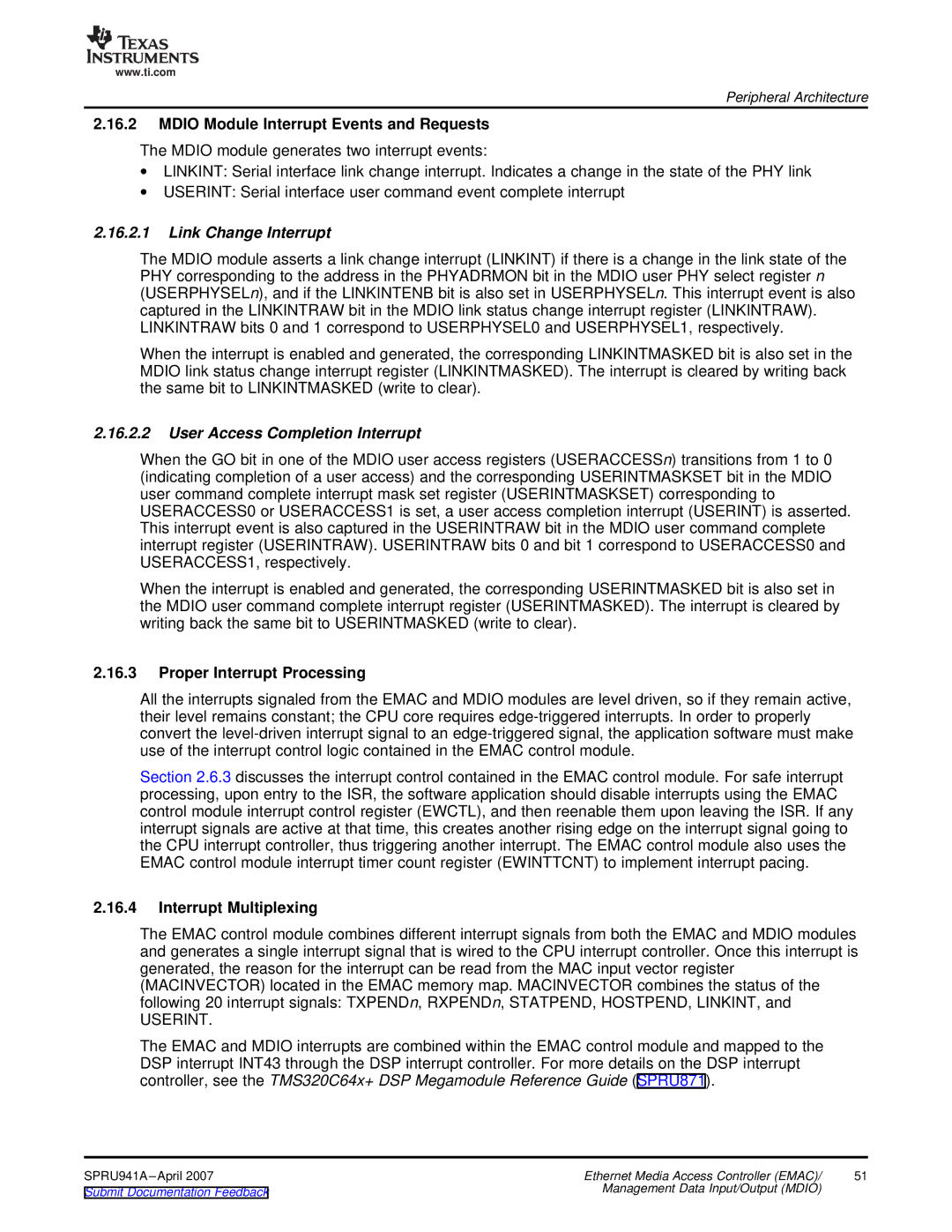
www.ti.com
Peripheral Architecture
2.16.2MDIO Module Interrupt Events and Requests
The MDIO module generates two interrupt events:
∙LINKINT: Serial interface link change interrupt. Indicates a change in the state of the PHY link
∙USERINT: Serial interface user command event complete interrupt
2.16.2.1Link Change Interrupt
The MDIO module asserts a link change interrupt (LINKINT) if there is a change in the link state of the PHY corresponding to the address in the PHYADRMON bit in the MDIO user PHY select register n (USERPHYSELn), and if the LINKINTENB bit is also set in USERPHYSELn. This interrupt event is also captured in the LINKINTRAW bit in the MDIO link status change interrupt register (LINKINTRAW). LINKINTRAW bits 0 and 1 correspond to USERPHYSEL0 and USERPHYSEL1, respectively.
When the interrupt is enabled and generated, the corresponding LINKINTMASKED bit is also set in the MDIO link status change interrupt register (LINKINTMASKED). The interrupt is cleared by writing back the same bit to LINKINTMASKED (write to clear).
2.16.2.2User Access Completion Interrupt
When the GO bit in one of the MDIO user access registers (USERACCESSn) transitions from 1 to 0 (indicating completion of a user access) and the corresponding USERINTMASKSET bit in the MDIO user command complete interrupt mask set register (USERINTMASKSET) corresponding to USERACCESS0 or USERACCESS1 is set, a user access completion interrupt (USERINT) is asserted. This interrupt event is also captured in the USERINTRAW bit in the MDIO user command complete interrupt register (USERINTRAW). USERINTRAW bits 0 and bit 1 correspond to USERACCESS0 and USERACCESS1, respectively.
When the interrupt is enabled and generated, the corresponding USERINTMASKED bit is also set in the MDIO user command complete interrupt register (USERINTMASKED). The interrupt is cleared by writing back the same bit to USERINTMASKED (write to clear).
2.16.3Proper Interrupt Processing
All the interrupts signaled from the EMAC and MDIO modules are level driven, so if they remain active, their level remains constant; the CPU core requires
Section 2.6.3 discusses the interrupt control contained in the EMAC control module. For safe interrupt processing, upon entry to the ISR, the software application should disable interrupts using the EMAC control module interrupt control register (EWCTL), and then reenable them upon leaving the ISR. If any interrupt signals are active at that time, this creates another rising edge on the interrupt signal going to the CPU interrupt controller, thus triggering another interrupt. The EMAC control module also uses the EMAC control module interrupt timer count register (EWINTTCNT) to implement interrupt pacing.
2.16.4Interrupt Multiplexing
The EMAC control module combines different interrupt signals from both the EMAC and MDIO modules and generates a single interrupt signal that is wired to the CPU interrupt controller. Once this interrupt is generated, the reason for the interrupt can be read from the MAC input vector register (MACINVECTOR) located in the EMAC memory map. MACINVECTOR combines the status of the following 20 interrupt signals: TXPENDn, RXPENDn, STATPEND, HOSTPEND, LINKINT, and
USERINT.
The EMAC and MDIO interrupts are combined within the EMAC control module and mapped to the DSP interrupt INT43 through the DSP interrupt controller. For more details on the DSP interrupt controller, see the TMS320C64x+ DSP Megamodule Reference Guide (SPRU871).
SPRU941A
Submit Documentation Feedback | Management Data Input/Output (MDIO) |
|
